From Alpine Catchment Classification to Debris Flow Monitoring
Abstract
1. Introduction
The Rio Frejus Catchment and Historical Series of Debris Flow Events
2. Materials and Methods
2.1. Catchment Characterization: From Geological–Geomorphological Analyses to Debris Flow Susceptibility Assessment
2.1.1. Lithological Catchment Classification
- Excellent Clay Maker (ECM): catchment bedrock mainly formed by thin-foliated metamorphic rocks, producing high quantity of clay grain-size sediments.
- Good Clay Maker (GCM): catchment bedrock mainly formed by massive carbonate rocks, producing moderate quantity of clayey silt grain-size sediments.
- Bad Clay Maker (BCM): catchment bedrock mainly formed by massive crystalline rocks, producing negligible quantity of fine sediment.
- ECM alluvial fans have a small size compared with the size of the feeding catchment (normally, the fan area is about 5% of the catchment area), with an irregular shape and low grain-size differentiation along the longitudinal axis of the fan (from apex to toe). The most frequent debris flow deposits are represented by clayey matrix-rich asymmetric levees in the cross-section with steep sides.
- GCM alluvial fans have a large size compared with the size of the feeding catchment (normally, the alluvial fan area is about 20% of the catchment area), with a regular flat-fan shape and low grain-size differentiation along the longitudinal axis of the fan (from apex to toe). The most frequent debris flow deposits are represented by clayey silt matrix-rich symmetric levees with a flat shape in the cross-section.
- BCM alluvial fans have a moderate size compared with the size of the feeding catchment (normally, the alluvial fan area is about 10% of the catchment area), with a regular lobate shape and high grain-size differentiation along the longitudinal axis of the fan (boulders in the apex area and silty sands at the toe, through abrupt transitions). The most frequent debris flow deposits are represented by matrix-free (or scarce silty sand matrix) levee-like boulder trains.
- Outcropping bedrock < 20% generates water flows.
- Outcropping bedrock ≥ 20%–≤54% generates hyperconcentrated flows.
- Outcropping bedrock ≥ 55% generates debris flows.
2.1.2. Debris Flow Propensity Index Assessment
- Outcropping lithologies and surficial deposits were derived from the ‘Foglio 153—Bardonecchia’ of the Geological Map of Italy at the scale of 1:50,000 [26].
- The slope and connectivity index were derived from the 5 × 5 m regional digital elevation model (DEM). Slope was calculated using the QGIS 3.4 software’s slope calculation tool. The procedure for deriving the CI is described in Section 2.1.3.
- Land use was obtained from the metadata of the Land Cover Piemonte 2021 project (https://geoportale.igr.piemonte.it/cms/progetti/land-cover-piemonte, accessed on 15 November 2024).
- Landslide distribution and activity were derived by merging the information from the Italian Landslide Inventory (IFFI, https://www.progettoiffi.isprambiente.it/, accessed on 15 November 2024) and the Landslide Information System of Piedmont region (SIFraP, https://www.arpa.piemonte.it/dato/sistema-informativo-frane-piemonte-sifrap, accessed on 15 November 2024).
2.1.3. Connectivity Index
2.1.4. Sediment Source Area Estimation
2.2. Debris Flow Monitoring
2.2.1. Monitoring System
- Station 1 (1731 m asl): monitoring the Rio Frejus main channel (at the confluence with Rio Merdovine, Rio Gaudet and Rio Comba Frejus) and equipped with a seismic sensor (EQ1) and accelerometer (ACM1).
- Station 2 (1688 m asl): monitoring the Rio Frejus main channel (downstream of the confluence with Rio Merdovine, Rio Gaudet and Rio Comba Frejus) and equipped with a seismic sensor (EQ4), accelerometer (ACM4) and water level meter (WLM1).
- Station 3 (1711 m asl): monitoring the Rio Frejus main channel (downstream of the confluence with Rio Merdovine, Rio Gaudet and Rio Comba Frejus) and equipped with a pull-cord (PC1).
- Station 4 (1680 m asl): monitoring the Rio Gautier sub-catchment (close to the confluence with the Rio Frejus main channel) and equipped with a seismic sensor (EQ2), accelerometer (ACM2) and water level meter (WLM2).
- Station 5 (1613 m asl): monitoring the Rio Frejus main channel (downstream of the confluence with Rio Gautier) and equipped with a seismic sensor (EQ3) and accelerometer (ACM3).
2.2.2. Unmanned Aerial Vehicle (UAV) Photogrammetry
3. Results
3.1. The Rio Frejus’ Debris Flow Susceptibility of Initiation Areas
- Rare boulders between 1 and 2 m3, showing sphericity ranging from prismoidal to sub-prismoidal, and occasionally spherical, with roundness from angular to very angular.
- Common blocks sized 0.50–0.70 m3, exhibiting sphericity from prismoidal to sub-discoidal and roundness from angular to very angular.
- Abundant cobbles and pebbles, with sphericity from prismoidal to discoidal and roundness from angular to very angular.
- Very abundant gravels characterized by sphericity from prismoidal to discoidal and a very angular roundness.
3.2. Actual Sediment Source Areas
3.3. Debris Flow Susceptibility Estimation
3.4. Observations Resulting from the Monitoring System
The Debris Flow Events of 30 July 2024 and 1 August 2024
4. Discussion
5. Conclusions
Author Contributions
Funding
Data Availability Statement
Acknowledgments
Conflicts of Interest
References
- Gregoretti, C.; Fontana, G. The triggering of debris flow due to channel-bed failure in some alpine headwater basins of the Dolomit6es. Analysis of critical runoff. Hydrol. Process. 2007, 22, 2248–2263. [Google Scholar] [CrossRef]
- Dowling, C.A.; Santi, P. Debris flow and their toll on human life: A global analysis of debris flow fatalities from 1950 to 2011. Nat. Hazards 2014, 71, 203–227. [Google Scholar] [CrossRef]
- Aaron, J.; McDougall, S.; Jordan, P. Dynamic analysis of the 2012 Johnson landslide at Kootenay Lake, British Columbia: The importance of undrained flow potential. Can. Geothech. J. 2019, 57, 1172–1182. [Google Scholar] [CrossRef]
- Jakob, M.; McDougall, S.; Santi, P. Advances in Debris-Flow Science and Practice; Springer Nature Switzerland AG: Cham, Switzerland, 2024; 636p. [Google Scholar] [CrossRef]
- Stoffel, M.; Tiranti, D.; Huggel, C. Climate change impacts on mass movements—Case studies from the European Alps. Sci. Total Environ. 2014, 493, 1255–1266. [Google Scholar] [CrossRef] [PubMed]
- Vagnon, F. Design of active debris flow mitigation measures: A comprehensive analysis of existing impact models. Landslides 2020, 17, 313–333. [Google Scholar] [CrossRef]
- Liu, K.; Wei, S. Real-time debris flow monitoring and automated warning system. J. Mt. Sci. 2024, 21, 4050–4061. [Google Scholar] [CrossRef]
- Okuda, S.; Suwa, H.; Okunishi, K.; Yokoyama, K.; Nakano, M. Observation of the motion of debris flow and its geomorphological effects. Z. Geomorphol. 1980, 35, 142–163. [Google Scholar]
- Berti, M.; Genevois, R.; LaHusen, R.; Simoni, A.; Tecca, P.R. Debris flow monitoring in the acquabona watershed on the Dolomites (Italian Alps). Phys. Chem. Earth (B) 2000, 25, 707–715. [Google Scholar] [CrossRef]
- Arattano, M.; Marchi, L. Systems and Sensors for Debris-flow Monitoring and Warning. Sensors 2008, 8, 2436–2452. [Google Scholar] [CrossRef]
- Coviello, V.; Arattano, M.; Comiti, F.; Macconi, P.; Marchi, L. Seismic Characterization of Debris Flows: Insights into Energy Radiation and Implications for Warning. J. Geophys. Res. Earth Surf. 2019, 124, 1440–1463. [Google Scholar] [CrossRef]
- Hürlimann, M.; Coviello, V.; Bel, C.; Guo, X.; Berti, M.; Graf, G.; Hübl, J.; Miyata, S.; Smith, J.B.; Yin, H.-Y. Debris-flow monitoring and warning: Review and examples. Earth-Sci. Rev. 2019, 199, 102981. [Google Scholar] [CrossRef]
- Cazorzi, F.; Dalla Fontana, G.; De Luca, A.; Sofia, G.; Tarolli, P. Drainage network detection and assessment of network storage capacity in agrarian landscape. Hydrol. Process. 2023, 27, 541–553. [Google Scholar] [CrossRef]
- Hungr, O.; Morgan, G.C.; VanDine, D.F.; Lister, D.R. Debris flow defenses in British Columbia. In Debris Flows/Avalanches: Process, Recognition, and Mitigation; Costa, J.E., Wieczorek, G.F., Eds.; Geological Society of America: Boulder, CO, USA, 1987; pp. 201–222. [Google Scholar] [CrossRef]
- Bosco, F.; Gandini, D.; Giudici, I.; Marco, F.; Paro, L.; Tararbra, M.; Tiranti, D. The Mass Movement of the Rio Frejus (Bardonecchia, NW Italian Alps) on 6 August 2004. In Evaluation and Prevention of Natural Risks; Campus, S., Barbero, S., Bovo, S., Forlati, F., Eds.; Taylor & Francis Group, Balkema: London, UK, 2007; pp. 409–447. [Google Scholar] [CrossRef]
- Tiranti, D.; Bonetto, S.; Mandrone, G. Quantitative basin characterization to refine debris-flow triggering criteria and processes: An example from the Italian Western Alps. Landslides 2008, 5, 45–57. [Google Scholar] [CrossRef]
- Tiranti, D.; Deangeli, C. Modeling of debris flow depositional patterns according to the catchments and sediment source areas characteristics. Front. Earth Sci. 2015, 3, 8. [Google Scholar] [CrossRef]
- Tiranti, D.; Crema, S.; Cavalli, M.; Deangeli, C. An Integrated Study to Evaluate Debris Flow Hazard in Alpine Environment. Front. Earth Sci. 2018, 6, 60. [Google Scholar] [CrossRef]
- Tiranti, D. Alpine Catchments’ Hazard Related to Subaerial Sediment Gravity Flows Estimated on Dominant Lithology and Outcropping Bedrock Percentage. GeoHazards 2024, 5, 652–682. [Google Scholar] [CrossRef]
- Piana, F.; Fioraso, G.; Irace, A.; Mosca, P.; d’Atri, A.; Barale, L.; Falletti, P.; Monegato, G.; Morelli, M.; Tallone, S.; et al. Geology of Piemonte region (NW Italy, Alps–Apennines interference zone). J. Maps 2017, 13, 395–405. [Google Scholar] [CrossRef]
- Tiranti, D.; Cremonini, R.; Marco, F.; Gaeta, A.R.; Barbero, S. The DEFENSE (DEbris Flows triggEred by storms—Nowcasting SystEm): An early warning system for torrential processes by radar storm tracking using a Geographic Information System (GIS). Comput. Geosci. 2014, 70, 96–109. [Google Scholar] [CrossRef]
- Tiranti, D.; Cremonini, R.; Asprea, I.; Marco, F. Driving Factors for Torrential Mass-Movements Occurrence in the Western Alps. Front. Earth Sci. 2016, 4, 16. [Google Scholar] [CrossRef]
- Bonetto, S.; Mosca, P.; Vagnon, F.; Vianello, D. New application of open source data and Rock Engineering System for debris flow susceptibility analysis. J. Mt. Sci. 2021, 18, 3200–3217. [Google Scholar] [CrossRef]
- Vianello, D.; Vagnon, F.; Bonetto, S.; Mosca, P. Debris flow susceptibility mapping using the Rock Engineering System (RES) method: A case study. Landslides 2022, 20, 735–756. [Google Scholar] [CrossRef]
- Hudson, J.A. Rock Engineering System: Theory and Practice; Ellis Horwood Series in Civil Engineering: New York, NY, USA, 1992; 185p. [Google Scholar]
- Polino, R.; Dela Pierre, F.; Fioraso, G.; Giardino, M.; Gattiglio, M. Foglio 132-152-153 “Bardonecchia” Carta Geologica d’Italia, Scala 1:50,000; Servizio Geologico d’Italia: Roma, Italy, 2002. [Google Scholar]
- Borselli, L.; Cassi, P.; Torri, D. Prolegomena to sediment and flow connectivity in the landscape: A GIS and field numerical assessment. Catena 2008, 75, 268–277. [Google Scholar] [CrossRef]
- Cavalli, M.; Trevisani, S.; Comiti, F.; Marchi, L. Geomorphometric assessment of spatial sediment connectivity in small Alpine catchments. Geomorphology 2013, 188, 31–41. [Google Scholar] [CrossRef]
- Crema, S.; Schenato, L.; Goldin, B.; Marchi, L.; Cavalli, M. Toward the development of a stand-alone application for the assessment of sediment connectivity. In Rendiconti Online Societa Geologica Italiana; Societa Geologica Italiana: Roma, Italy, 2015; pp. 58–61. [Google Scholar] [CrossRef]
- Brabb, E.E. Innovative Approaches to Landslide Hazard and Risk Mapping. In International Landslide Symposium Proceedings; Landslide Society: Tokyo, Japan, 1985; Volume 1, pp. 17–22. [Google Scholar]
- Schiavo, M.; Gregoretti, C.; Boreggio, M.; Barbini, M.; Bernard, M. Probabilistic identification of debris-flow pathways in mountain fans within a stochastic framework. J. Geophys. Res. Earth Surf. 2024, 129, e2024JF007946. [Google Scholar] [CrossRef]
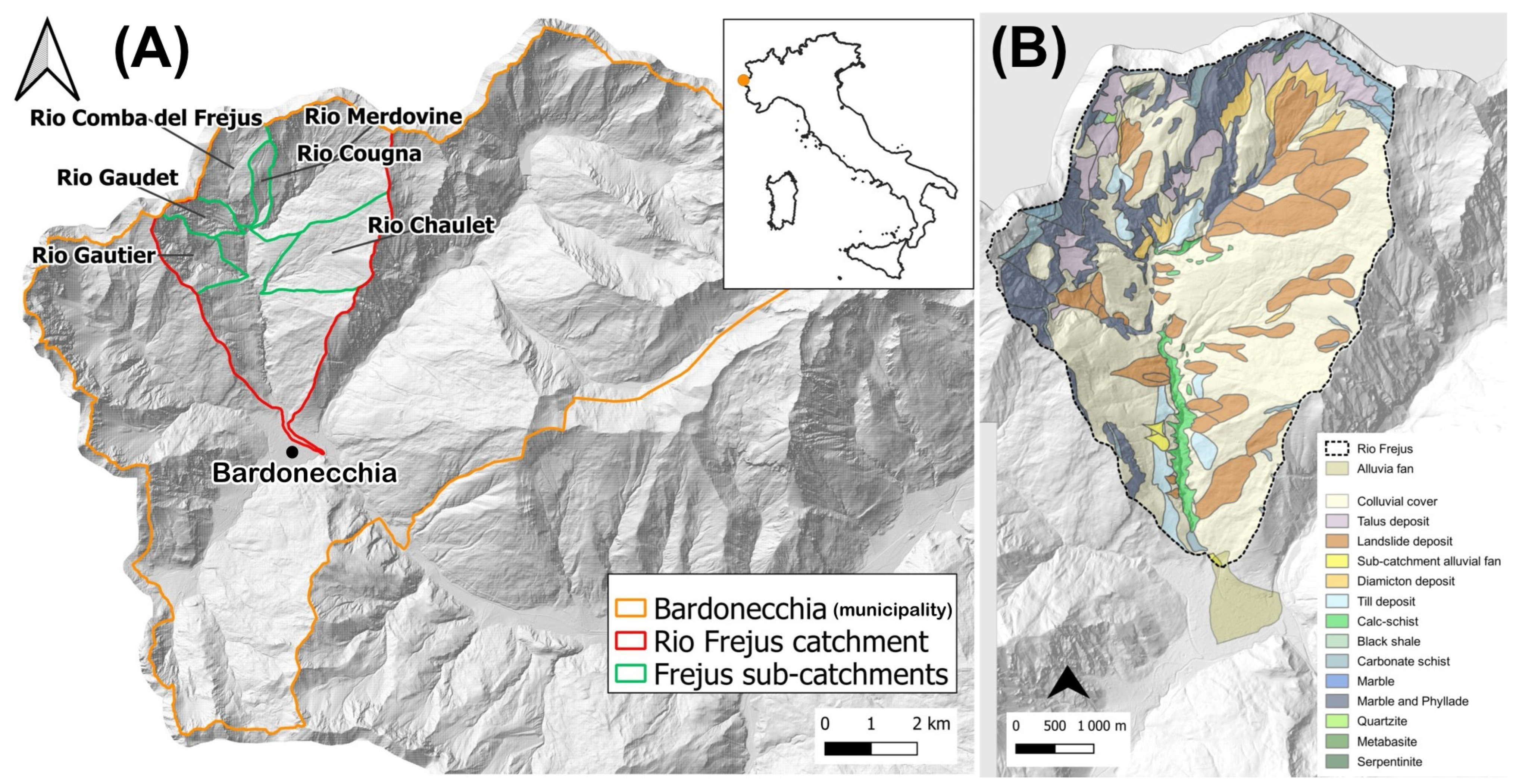
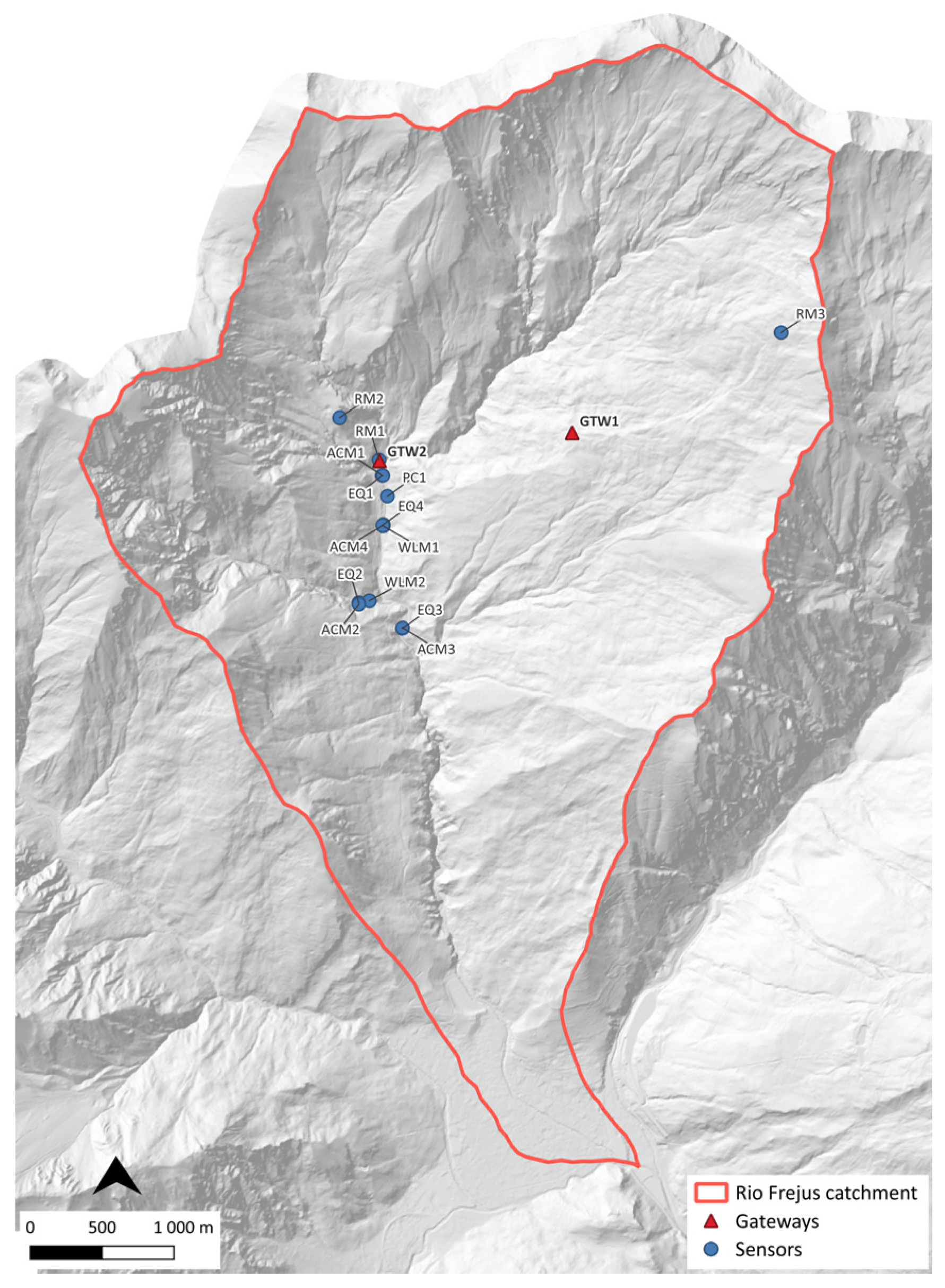
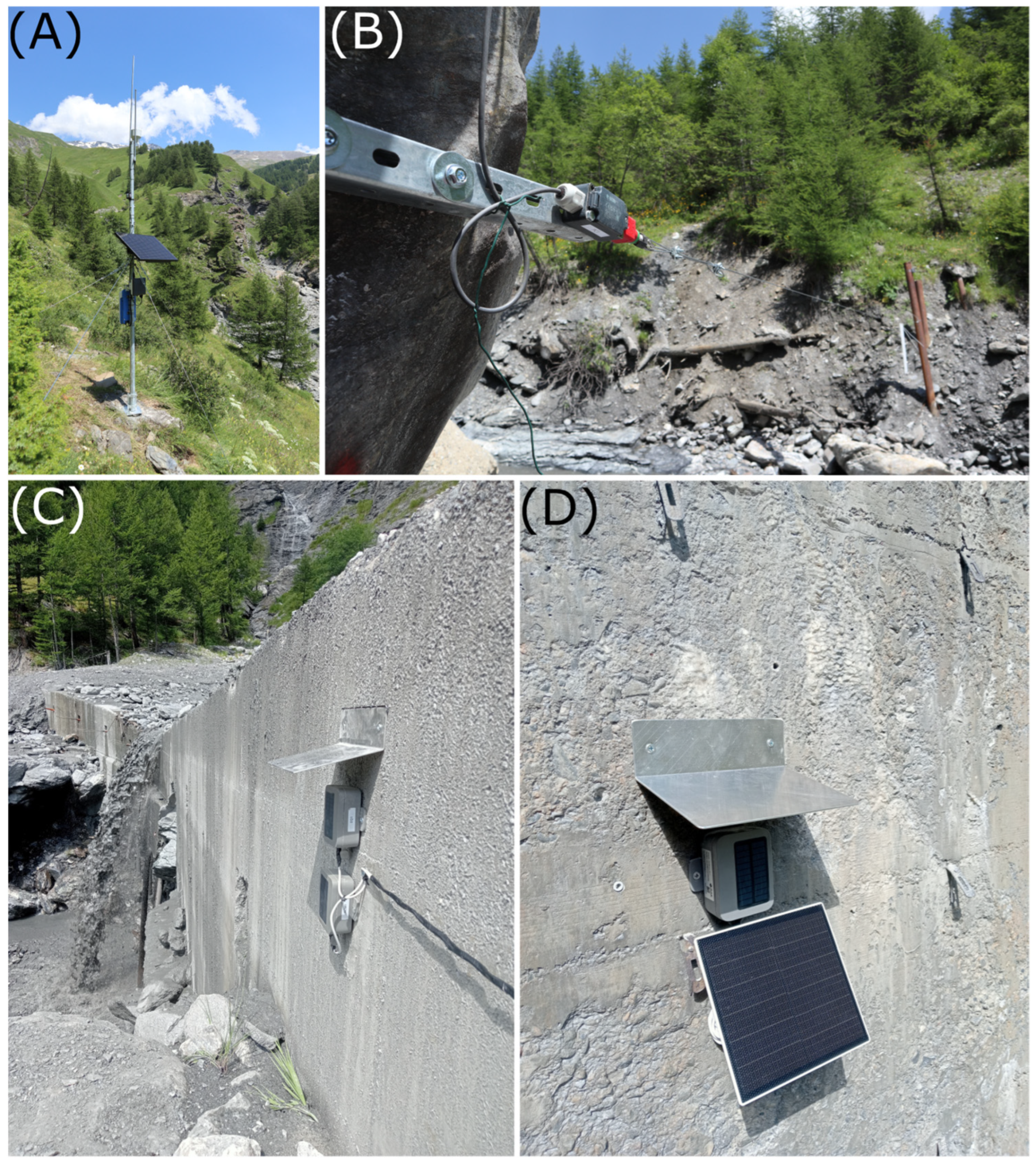
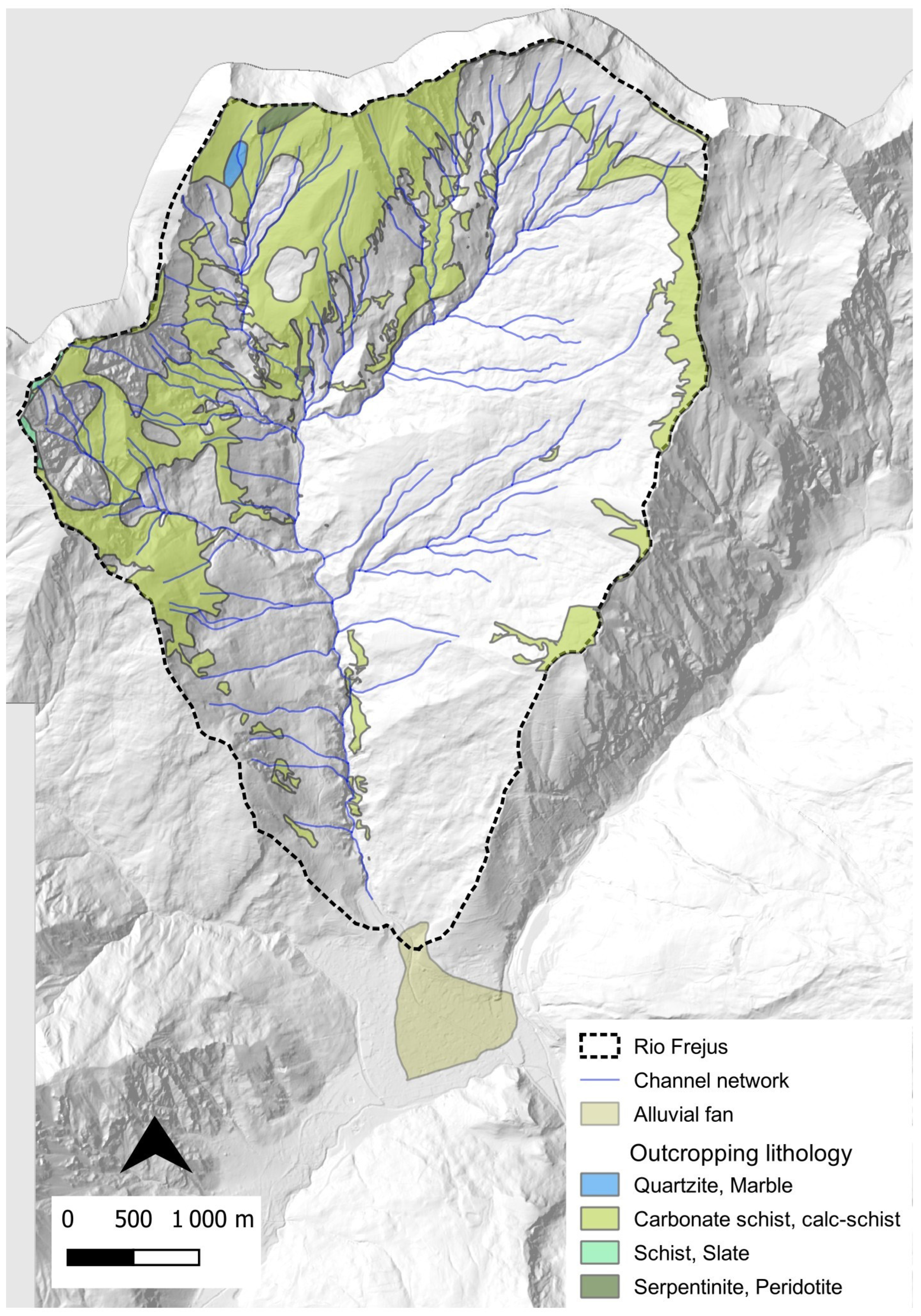
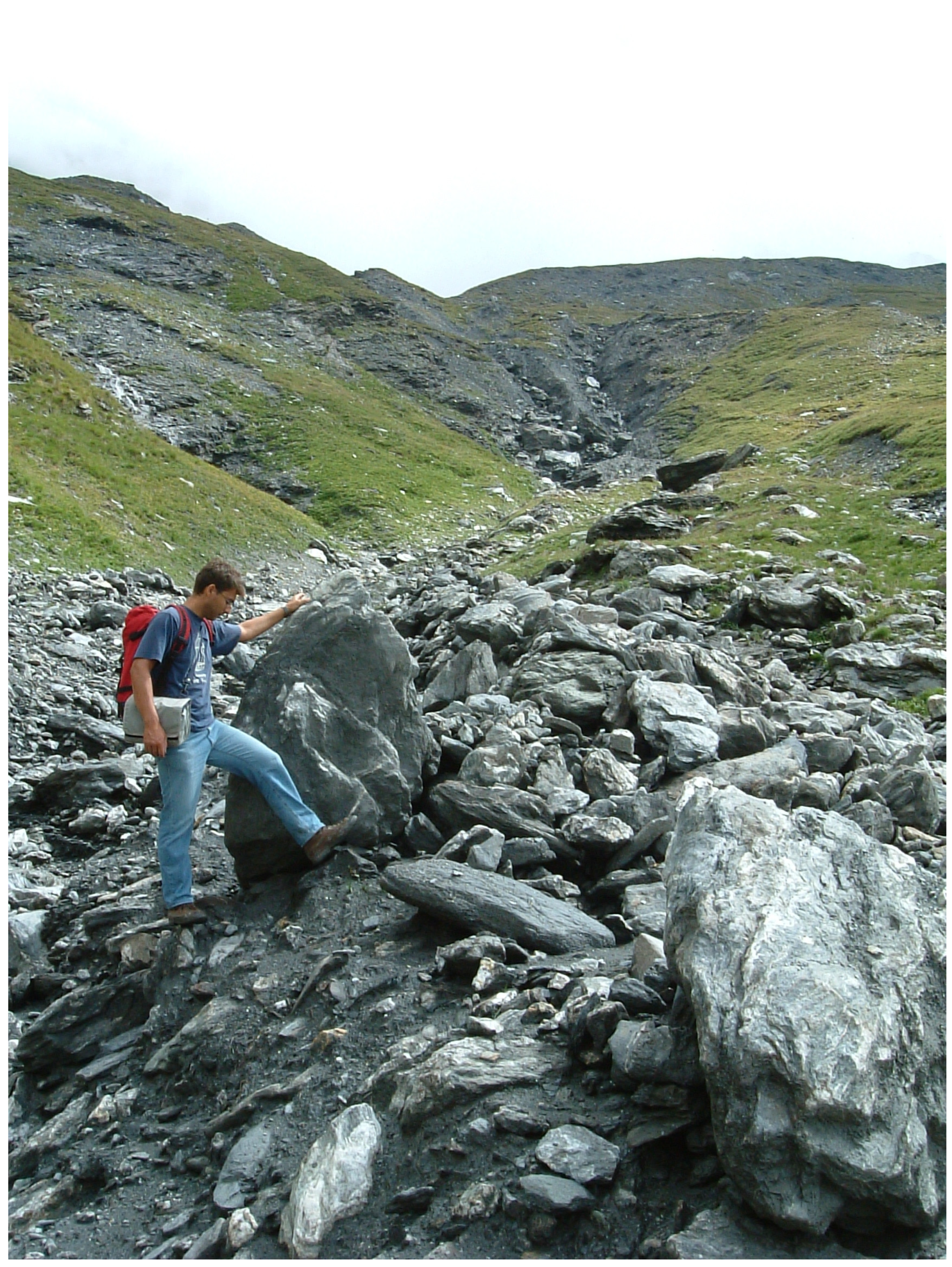
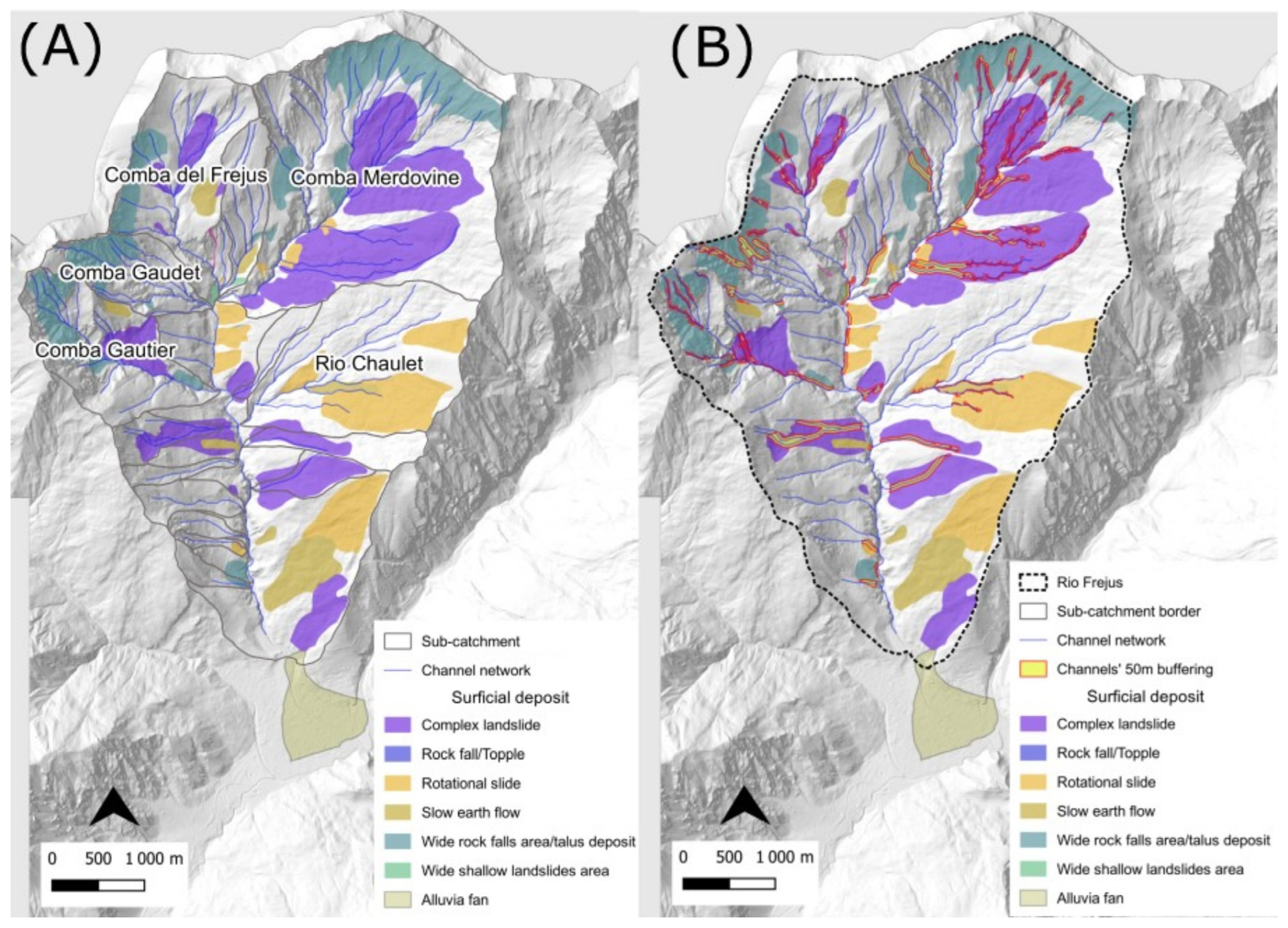
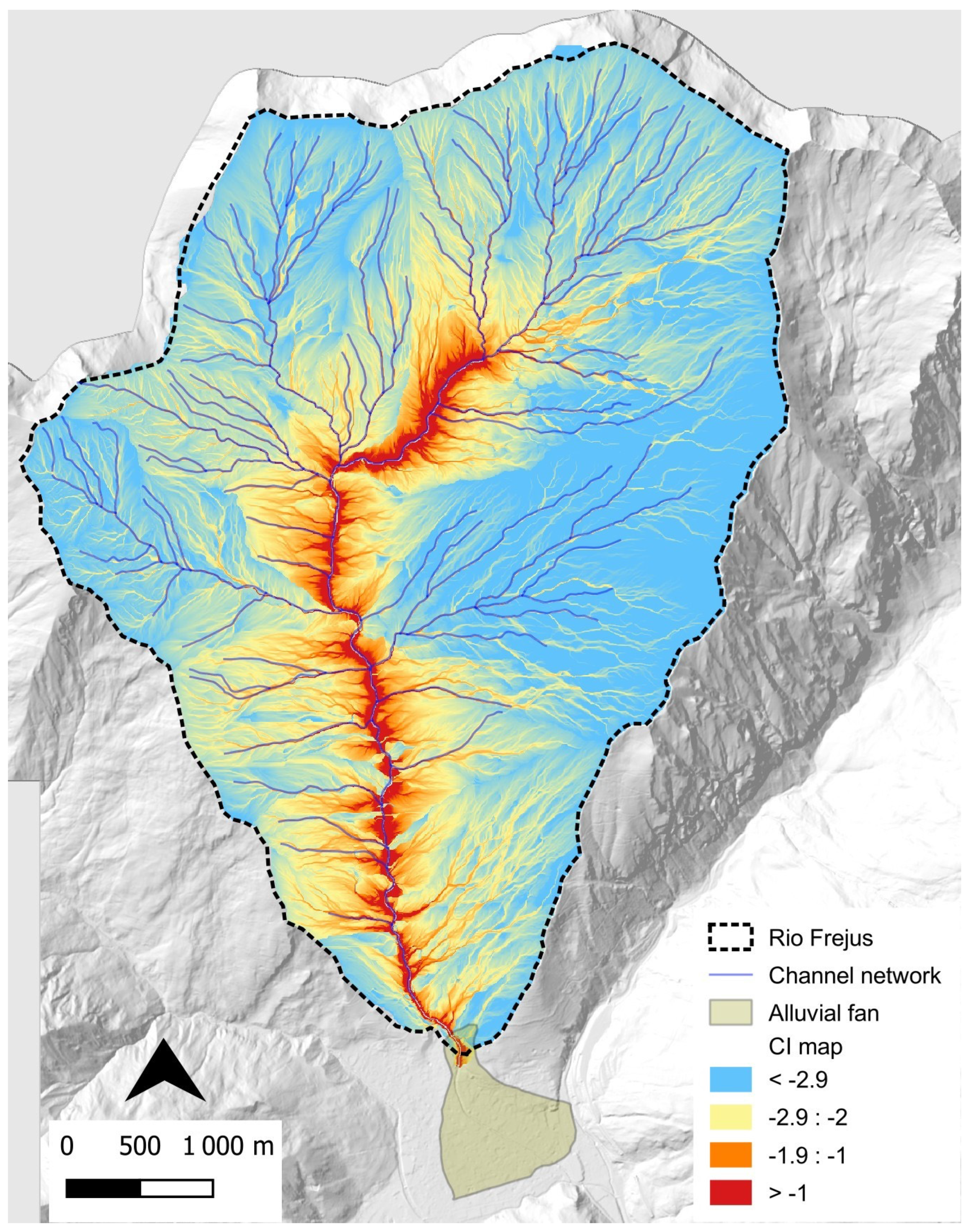
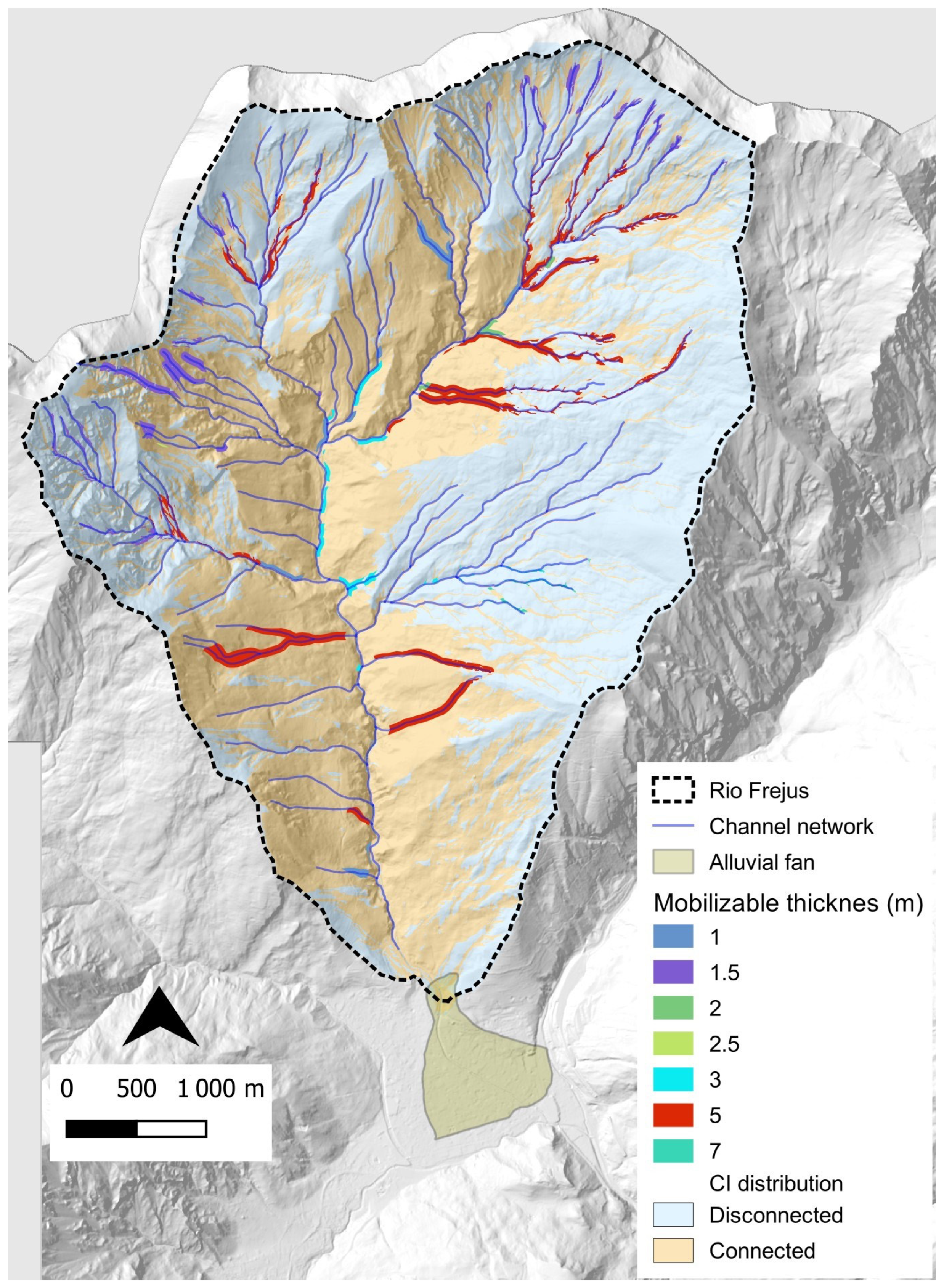
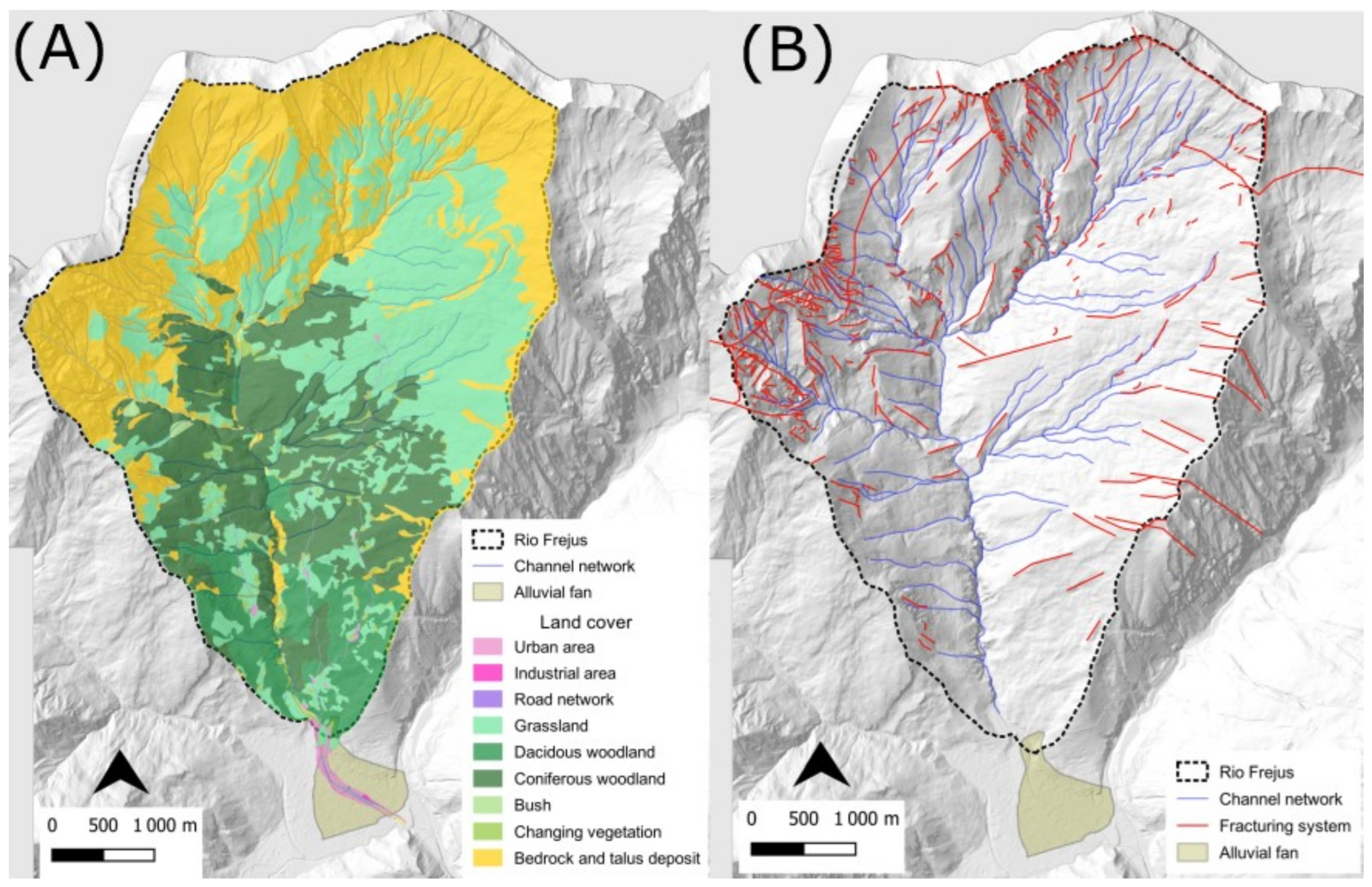

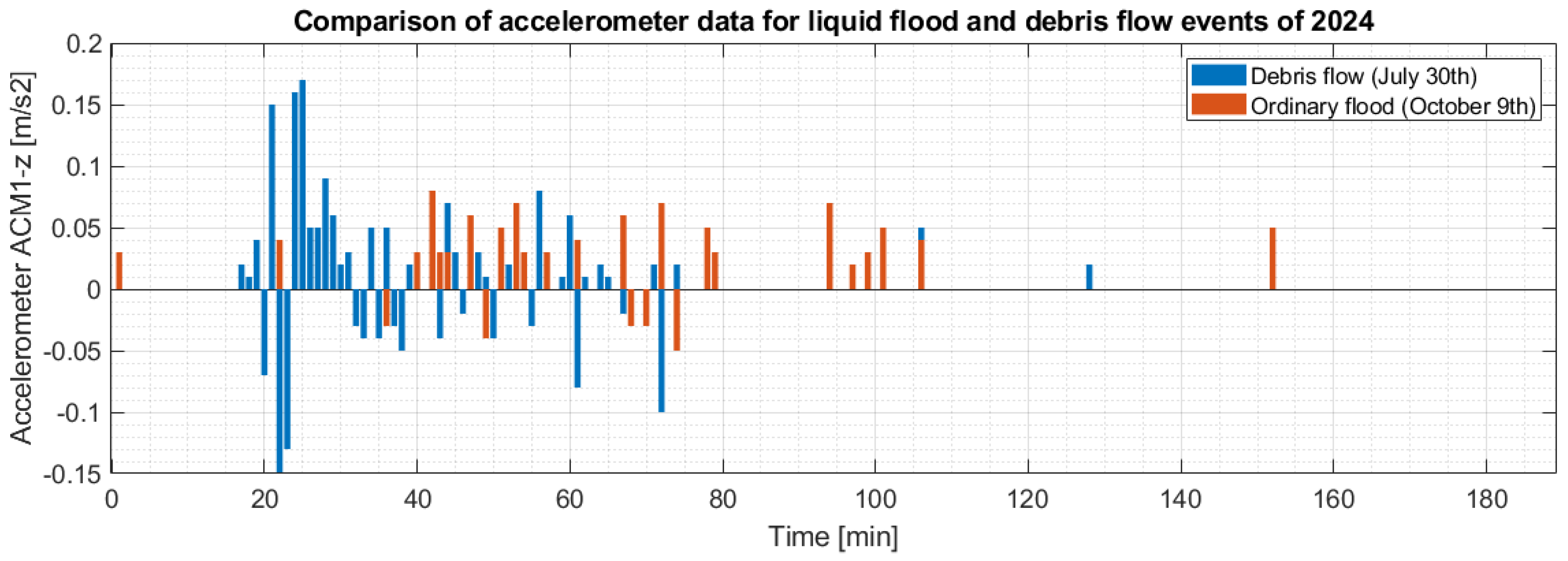


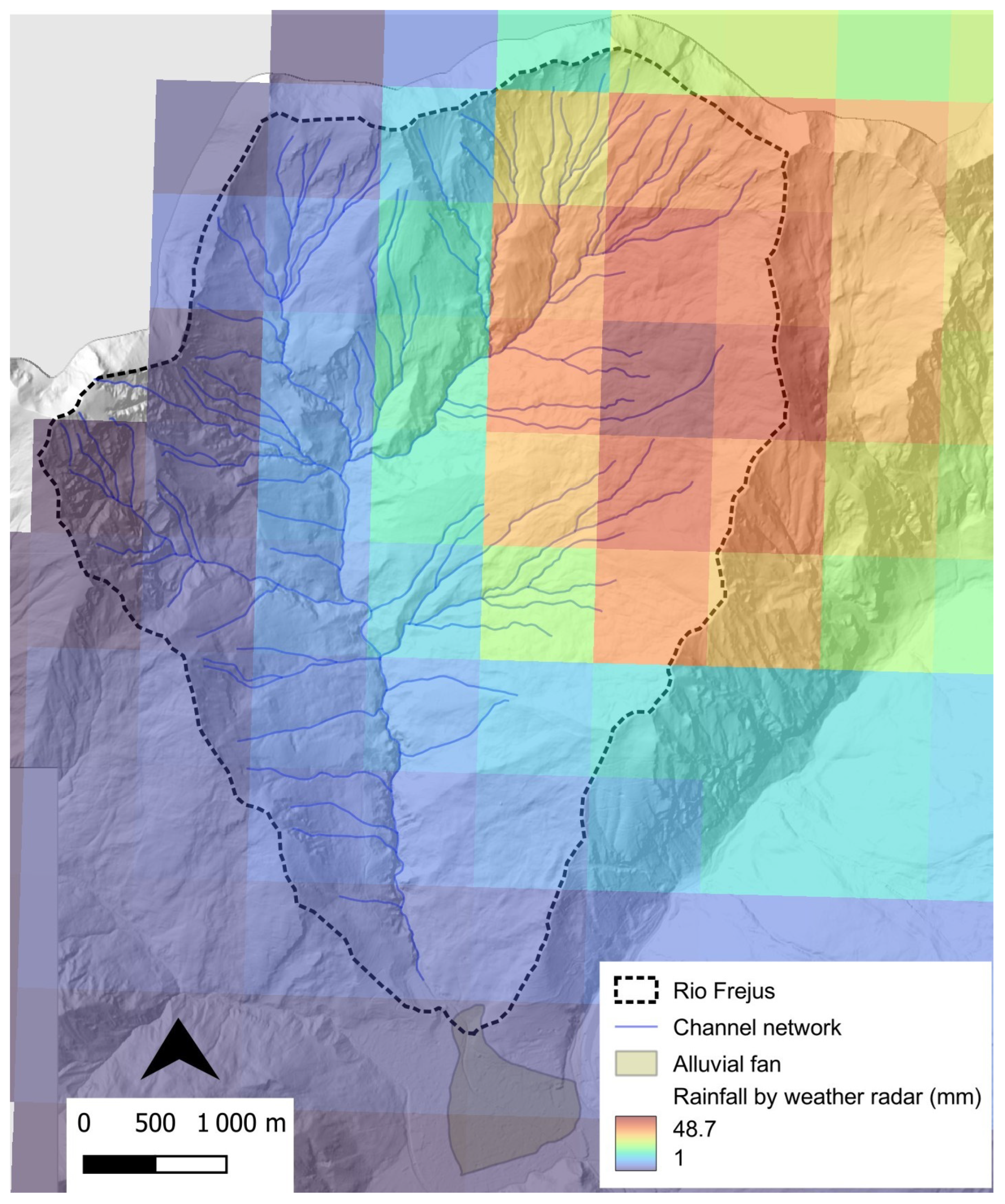


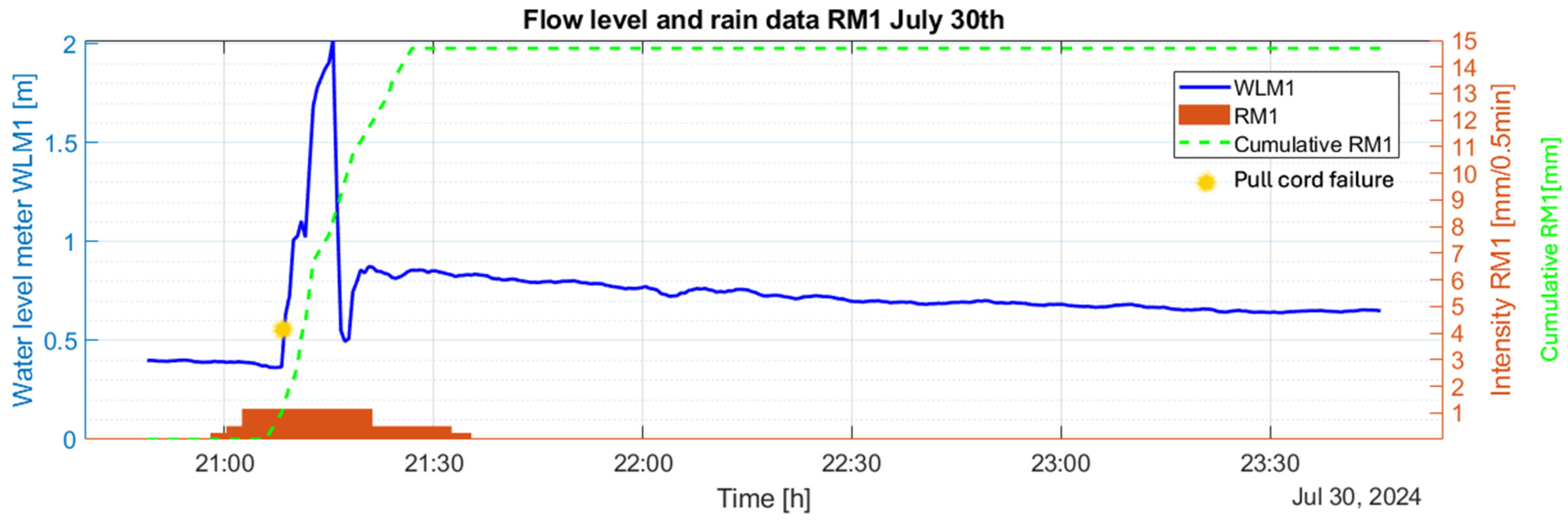

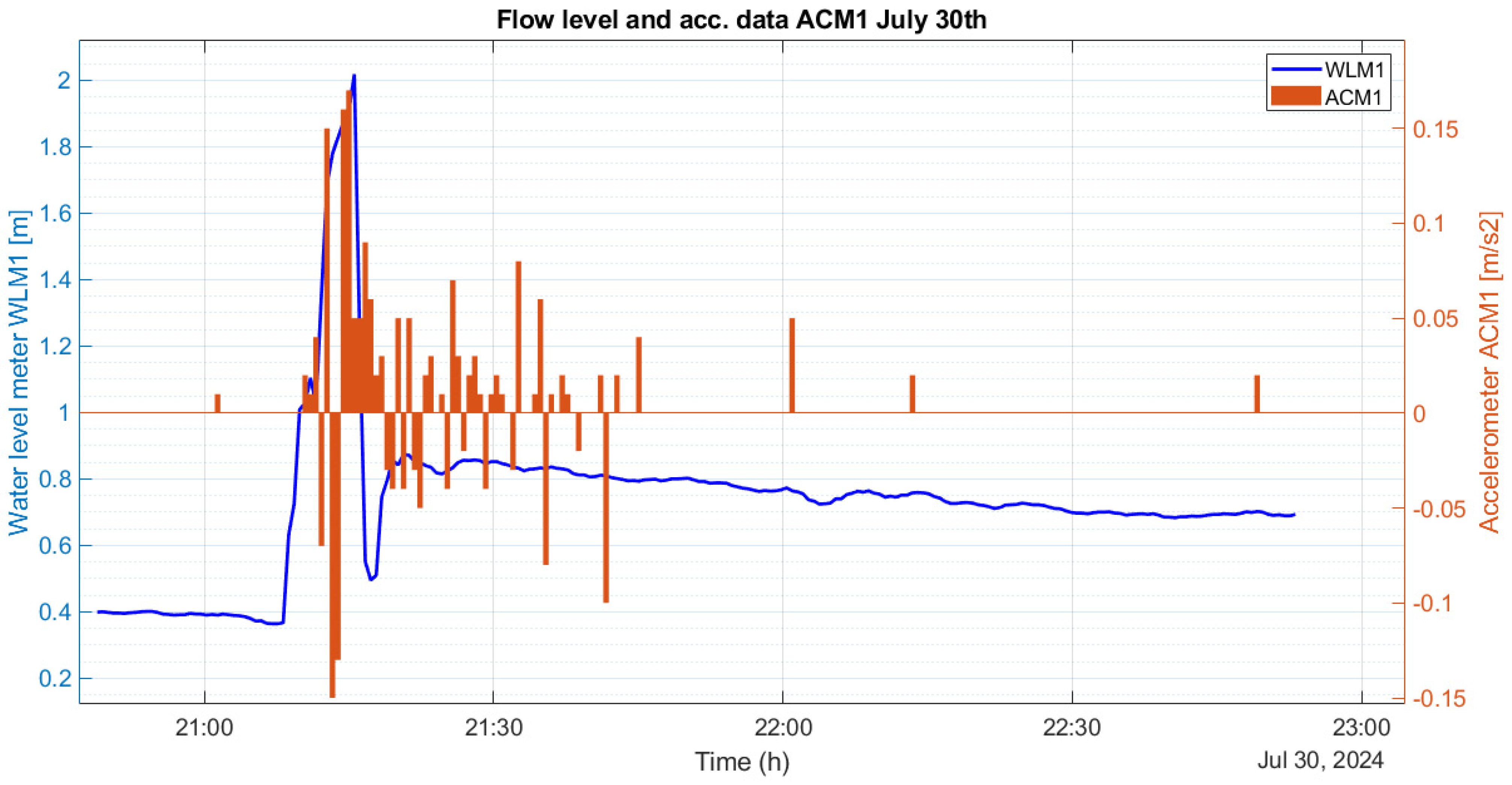
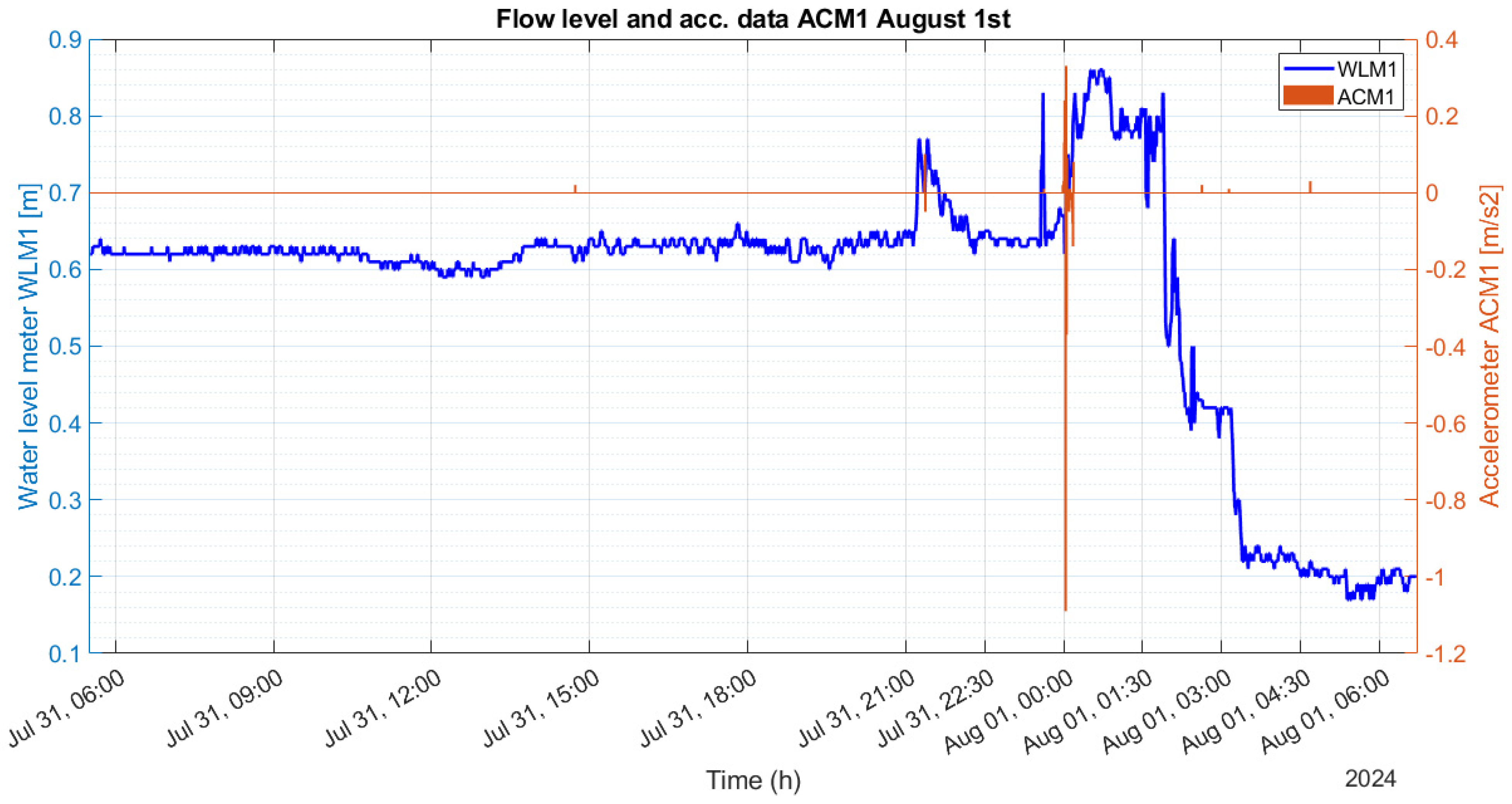
| Catchment Parameter | Value |
|---|---|
| Catchment area [km2] | 22.32 |
| Main incised channel length (from catchment head to alluvial fan toe) [km] | 9.42 |
| Average catchment slope [°] | 28.1 |
| Max elevation (at watershed) [m asl] | 3.14 |
| Min elevation (at alluvial fan toe) [m asl] | 1.25 |
| Average elevation [m asl] | 2.19 |
| Alluvial fan area [km2] | 0.43 |
| Fan/catchment area ratio [%] | 1.93 |
| Bedrock outcropping area [km2] | 5.27 |
| Bedrock outcropping percentage [%] | 23.63 |
| Landslide deposits area [km2] | 8.56 |
| Landslide deposits percentage [%] | 38.36 |
| Surficial deposits and eluvial–colluvial cover area [km2] | 8.48 |
| Surficial deposits and eluvial–colluvial cover percentage [%] | 38.00 |
| Sub-Catchment | Date | Time | Flow Type Observed at the Alluvial Fan |
|---|---|---|---|
| - | July 1914 | - | - |
| - | September 1920 | - | - |
| - | 3 August 1934 | - | mud–debris flow |
| - | 12 June 1947 | - | - |
| - | 4 September 1948 | - | - |
| Merdovine | 2 May 1949 | - | mud–debris flow |
| Merdovine | 26 May 1951 | - | mud–debris flow |
| - | 21 June 1954 | - | mud–debris flow |
| - | 21 August 1954 | - | mud–debris flow |
| - | 8 June 1955 | - | mud–debris flow |
| - | 13 June 1957 | - | - |
| - | 18 October 1966 | - | - |
| - | 3 November 1968 | - | mud–debris flow |
| Gautier | 7 August 1997 | 4:15–4:30 p.m. | mud–debris flow |
| Gautier | 21 June 2002 | - | mud–debris flow |
| Gautier | 6 August 2004 | 8:00 p.m. | debris flow |
| Gautier | 25 July 2006 | 8:30 p.m. | mud–debris flow |
| Gautier, Merdovine and Gaudet | August 2006 | - | mud–debris flow |
| Merdovine | 7 August 2009 | 7:00 p.m. | debris flow |
| Gautier | 16 July 2013 | 7:45 p.m. | mud–debris flow |
| - | 17 July 2013 | 7:45 p.m. | mud–debris flow |
| - | 9 August 2015 | - | mud–debris flow |
| - | 8 August 2017 | 7:30 p.m. | mud–debris flow |
| Merdovine | 13 August 2023 | 9:00 p.m. | debris flow |
| Merdovine | 30 July 2024 | 8:30–9:00 p.m. | mud–debris flow |
| Sensor | Number | Sampling Frequency | Unit of Measure | Sensitivity | Range |
|---|---|---|---|---|---|
| Rain gauge (RM) | 3 | 30 s | mm | 0.25 mm | 0-Inf |
| Accelerometer (ACM) | 4 | 30 s | m/s2 | 0.01 m/s2 | ±2 g |
| Seismic sensor (EQ) | 4 | 30 s | m/s2 | 0.01 m/s2 | ±2 g |
| Water level meter (WLM) | 2 | 30 s | mm | 1 mm | 0.5–10 m |
| Pull-cord (PC) | 1 | 30 s | / | / | 0–1 |
| UAV DJI Mavic 3 | |
|---|---|
| RGB camera | CMOS 4/3″ |
| Sensor length [mm] | 13 |
| Sensor width [mm] | 17.3 |
| Sensor resolution [MP] | 20 |
| Image dimension [px] | 5280 × 3956 |
| Focal length [mm] | 24 |
| Date | Images | Designed GSD | Obtained GSD | Flight Altitude |
|---|---|---|---|---|
| Survey 1: 30 July 2024 | 4825 | 3.2 cm | 5 cm | Manual |
| Survey 2: 20 August 2024 | 3618 | 4.75 cm | 5 cm | 75 m |
| Matrix A—Lithology | ||||||||
|---|---|---|---|---|---|---|---|---|
| a/a | 1 | 2 | 3 | 4 | 5 | C | C + E | ai |
| 1 | Lithology | 2 | 2 | 1 | 1 | 6 | 10 | 3.57 |
| 2 | 0 | Slope | 4 | 3 | 0 | 7 | 17 | 6.07 |
| 3 | 0 | 3 | Connectivity | 2 | 1 | 6 | 18 | 6.43 |
| 4 | 1 | 2 | 2 | Land use | 0 | 5 | 12 | 4.29 |
| 5 | 3 | 3 | 4 | 1 | Fracturing density | 11 | 13 | 4.64 |
| E | 4 | 10 | 12 | 7 | 2 | 70 | 25 | |
| Matrix B—Deposits | ||||||||
|---|---|---|---|---|---|---|---|---|
| a/a | 1 | 2 | 3 | 4 | 5 | C | C + E | ai |
| 1 | Deposits | 2 | 2 | 2 | 2 | 8 | 19 | 4.85 |
| 2 | 4 | Slope | 4 | 3 | 3 | 14 | 23 | 5.87 |
| 3 | 3 | 3 | Connectivity | 2 | 3 | 11 | 21 | 5.36 |
| 4 | 1 | 2 | 2 | Land use | 1 | 6 | 16 | 4.08 |
| 5 | 3 | 2 | 2 | 3 | Landslide activity | 10 | 19 | 4.85 |
| E | 11 | 9 | 10 | 10 | 9 | 70 | 25 | |
| Matrix A—Lithology | Matrix B—Deposits | ||||
|---|---|---|---|---|---|
| Parameter | Class | Pj | Parameter | Class | Pj |
| Lithology | Quartzites | 0 | Deposits | No deposit | 0 |
| Gneiss, quartz mica schist | 1 | Talus deposits | 2 | ||
| Marble and dolostone | 2 | Glacial deposits | 2 | ||
| Calc-schist and mica schist | 4 | Landslide deposits | 3 | ||
| Gypsum and carbonate breccias | 4 | Eluvial–colluvial deposits | 4 | ||
| Slope | 0–8° | 0 | Slope | 0–8° | 0 |
| 9–15° | 1 | 9–15° | 1 | ||
| 16–25° | 3 | 16–25° | 3 | ||
| 26–35° | 4 | 26–35° | 4 | ||
| >35° | 2 | >35° | 2 | ||
| Connectivity | Low (≤−2.9) | 1 | Connectivity | Low (≤−2.9) | 1 |
| Medium-low (−2.9: −2.3) | 2 | Medium-low (−2.9: −2.3) | 2 | ||
| Medium-high (−2.3: −1.3) | 3 | Medium-high (−2.3: −1.3) | 3 | ||
| High ≥ −1.3) | 4 | High (≥−1.3) | 4 | ||
| Land use | Villages, urban | 0 | Land use | Villages, urban | 0 |
| High forests | 1 | High forests | 1 | ||
| Low forests | 2 | Low forests | 2 | ||
| Grassland | 2 | Grassland | 2 | ||
| Rock and deposits | 4 | Rock and deposits | 4 | ||
| Fracturing density | Weak | 0 | Landslide activity | -- | 0 |
| Moderate | 1 | Nd | 1 | ||
| Strong | 2 | Stabilized | 2 | ||
| Very Strong | 3 | Quiescent | 3 | ||
| Intense | 4 | Active | 4 | ||
Disclaimer/Publisher’s Note: The statements, opinions and data contained in all publications are solely those of the individual author(s) and contributor(s) and not of MDPI and/or the editor(s). MDPI and/or the editor(s) disclaim responsibility for any injury to people or property resulting from any ideas, methods, instructions or products referred to in the content. |
© 2025 by the authors. Licensee MDPI, Basel, Switzerland. This article is an open access article distributed under the terms and conditions of the Creative Commons Attribution (CC BY) license (https://creativecommons.org/licenses/by/4.0/).
Share and Cite
Cantonati, F.; Lissari, G.; Vagnon, F.; Paro, L.; Magnani, A.; Rossato, I.; Donati Sarti, G.; Barresi, C.; Tiranti, D. From Alpine Catchment Classification to Debris Flow Monitoring. GeoHazards 2025, 6, 15. https://doi.org/10.3390/geohazards6010015
Cantonati F, Lissari G, Vagnon F, Paro L, Magnani A, Rossato I, Donati Sarti G, Barresi C, Tiranti D. From Alpine Catchment Classification to Debris Flow Monitoring. GeoHazards. 2025; 6(1):15. https://doi.org/10.3390/geohazards6010015
Chicago/Turabian StyleCantonati, Francesca, Giulio Lissari, Federico Vagnon, Luca Paro, Andrea Magnani, Ivano Rossato, Giulio Donati Sarti, Christian Barresi, and Davide Tiranti. 2025. "From Alpine Catchment Classification to Debris Flow Monitoring" GeoHazards 6, no. 1: 15. https://doi.org/10.3390/geohazards6010015
APA StyleCantonati, F., Lissari, G., Vagnon, F., Paro, L., Magnani, A., Rossato, I., Donati Sarti, G., Barresi, C., & Tiranti, D. (2025). From Alpine Catchment Classification to Debris Flow Monitoring. GeoHazards, 6(1), 15. https://doi.org/10.3390/geohazards6010015








